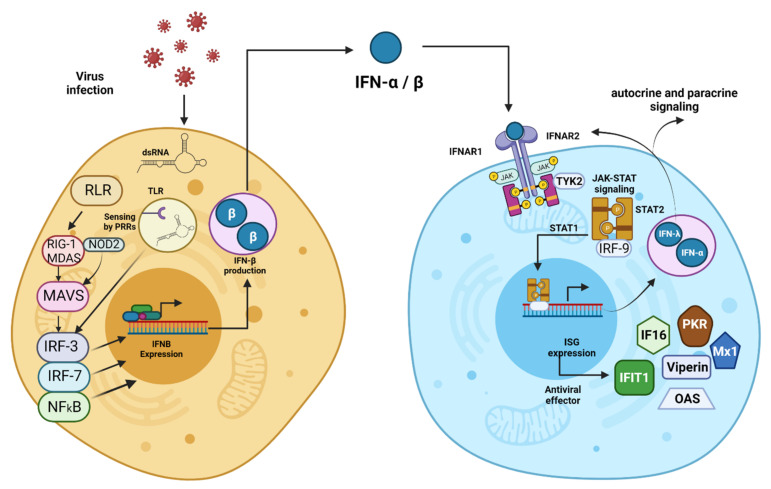Figure 1.
Type I Interferons Induction and Functions. Type I IFNs are first induced intrinsically in infected cells through a process of host cell recognition of segments of DNA or RNA or other viral macromolecules called pathogen-associated molecular patterns (PAMPs). PAMPs recognition as non-self-starts with their binding to specific cellular pathogen recognition receptors (PRRs), such as Toll-like receptors (TLRs), RIG-I-like receptors (RLRs), NOD-like receptors. Receptor-ligand binding triggers the type I IFN induction cascade via NFκß, resulting in the activation and translocation to the nucleus of IFN regulatory factors IRF3 and IRF7, which induce the expression of type I IFNs. The expressed cytokine is exported to the extracellular milieu and binds to IFNAR, a heterodimeric receptor consisting of two subunits, IFNAR1 and IFNAR2. The molecule forms a trimeric structure with the receptor, thus activating the proteins Janus kinase 1 (JAK1) and tyrosine kinase 2 (TYK2). These proteins activate the signal transducers and activators of transcription 1 and 2 (STAT1 and STAT2), which induce the transcription of interferon-stimulated genes (ISGs) by forming a complex with IRF9. These ISGs encode antiviral effectors (PKR, Mx1, OAS, etc.) and activate type I IFN production, thus triggering autocrine and paracrine signaling. Cells from the innate immune system, such as dendritic cells (DCs) and macrophages, produce type I IFN after sensing pathogen components using various PRRs found on the plasma membrane, in endosomes, and throughout the cytosol. Created with BioRender.com.

